No shells at risk
Many things have been said of animals as beautiful as unknown. “Orchids with angiosperes or butterflies with arthropods are the same as opistols with molluscs. They are among the most interesting and spectacular invertebrates” (T.E. Thompson, Biology of opisthobranch molluscs). Its colorations and epidermal images, as well as its peculiar appendices, are as beautiful as the platihelminths. Its skin is formed by bright colors: red, blue, yellow, black, green and others.
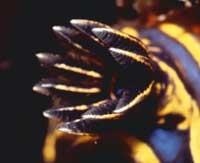
But this wonderful colouring for human sight is a sign that for the rest of the animals that live with them in the sea we must be careful often. Predators know that eating animals of this type with very vivid colors can be dangerous (at best it would have a bad taste, at least not to want to taste again).
Opistobranquios are marine, with an absurd lung developed by their relatives, the terrestrial lung snails. In this way, the colorful gills seen on the surface make them even more beautiful, due to its beautiful extension. But besides the appearance of these gills, there is another curious thing: its origin. These gills are developed in a secondary way, that is, those that had in the first place once disappeared and that although they were used primarily for respiration and filtration (in some way food), these secondary ones do for respiration, but instead of filtering food, will fulfill another different but important function: protection.
Gills can be simple and spectacular, with a presence of up to twenty in some species. On other occasions, however, we will not be able to see any of them and they will have the form of a simple spleen: a marine and colorful spleen.
As has happened in several snails, there has been a process of limification in the opistobranquios, a tendency to lose the shell. This evolutionary trend has been very evident in these cases. The more developed will not retain nor trace of shell, but other more primitive opistols that have been evolutionarily interpreted as intermediate steps. As it is a continuous process, some have a simple internal shell and a few still have an obvious external shell. But the most spectacular are those without shells, and among them, the nudibranchs are the most abundant, those that would most resemble these sea squids.
However, one might think that this phenomenon has left nature unprotected (evolution). After all, why do snails drag their house to shore if it is not for being a good refuge? Therefore, opistobranchios have had to develop a form of alternative protection and appropriate to the loss of the shell; although it is not the only one, other groups of animals have done their thing: coloring.
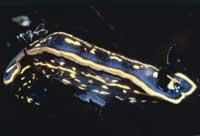
On the one hand, evolution, and therefore natural selection, has endowed these animals with an aposematic coloration. The vivid colors indicate “beware, danger!” in the animal world, “to the prey, do not eat me!” And it seems to have been useful in many cases, for example. This aposematic coloration will not exonerate itself from death, but once ingested more than one opistobranquio of these characteristics, and year after year, what we could call general memory in the animals of the area will be produced. And in the end everyone will know that you can not eat opistobranquios of bright colors
This means for everyone, more than the success of this particular group, a form of coloring, since, in addition to the opistobranquios, many other groups of animals have been used to defend themselves. Is there anything better than “respect” for others to survive in Nature?
Of course not. If not, ask them to take advantage of that, and that they have no poison in the skin, that they want to imitate the coloring of those who have... There are opistols that with mimicry have managed to pretend to be “dangerous”. In nature everything is allowed! From this moment on, only his cunning and bravery will help the predator decide if the opistobranquio in front is aposematic or mimetic.
Others prefer to go unnoticed. This is achieved with a coloration similar to the substrate through which they circulate. This phenomenon can be easily understood knowing that this substrate is the typical food of opistobranquios and that the body of these molluscs opistobranquios is transparent. Therefore, the pigments they contain will come from the same colors as the substrate. This is typical of sacks, which according to the algae they eat are green, brown or red. This similarity with the substrate makes them invisible to predators, but they should not be of low colors. This is called cryptic coloring, used to hide.
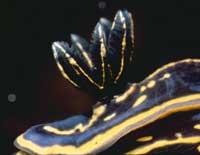
Predatory/prey pairs of the same colour (opistobrankio/alimentation) are easily noteworthy: Aldisa banyulensis/Hemimycale columella (doridazeo/belaki duo), Catriona aurantia/Tubularia indivisa (wind duo/knidario),... For example, the aforementioned living beings are red.
Here, however, the protection mechanisms of opistobranquios do not end at all. As can be seen in one of the aforementioned couples, some opistobranchios are able to feed on various species of cnidaria, such as jellyfish and polyp. How can these small molluscs eat living things that can be so dangerous? In short, cnidarians usually contain in their epidermis and gastrodermia, cnidocists and/or nematocysts that internalize urticant substances in the enemy. But some opistobranquios, the eóescriteos, will be able to feed not only the cnidarios, but their nematocistas, to use them later for their own exploitation (protection), which will be thrown to their predators.
To do this, they will have to solve two main problems: on the one hand, destroy in some way the defenses of the dam and, on the other, ensure that the urticantes capsules that they catch with the food are not thrown during their stay in the iron pipe, so that they are reused, directing them to the dorsal appendices that will be stored.
The eolic ones that solve the first problem through immune and anesthetic secretions, and in the second, special vesicles present in the epithelium of the digestive tract will be important; in addition, the cited fluids will protect from the variation of the osmotic pressure that would cause the release of the cnidocysts in the digestive tract of the eóleos (high osmotic pressure in hydrostatic capsule).
In this way, those of the genus Aeolis and others will have in their skin confusions or external increases, called cats and with internal diverticula of the digestive tract. In these diverticula they will have hives cells and if any other animal assaults the opistobranquio, all of them will be launched immediately forming a cloud. We now know that they are not molluscum cells, but knidoblasts of anemones and ingested hydrozoans.
All of this should be related to the theme of the above-mentioned aposematic coloration, as these stolen defenses are usually located in those brightly colored areas. The aposematic color is not only the expression of an unpleasant taste. In addition to these poisonous fluids and acids that will give this flavor, there are others: exocrine glands, cnidogenic sacs and epidermal vacuoles. The color would indicate an unpleasant taste and the toxic substances and/or knidocists present.
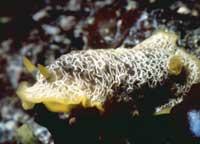
In addition, these things have another important advantage: they often have an autotomy capability. That is to say, if any predator dung from it, these appendages would be able to detach from the rest of the body (as lizards can lose the tail or starfish), freeing the same animal from death.
Opistobranchios are gastronopod molluscs but have some difference with most gastropods. To begin with, their shell has been disappearing throughout history, because perhaps, as has been said, they have been able to find other types of support (but it cannot be said that one is a direct consequence of the other). They have preferred to leave naked, making disappear that shell that cost so much older mollusks (since adapting to an evolutionary achievement of these characteristics is always difficult at first, although then the benefits that can report are numerous). But these have left the house to drag and a few have adapted to swim.
The constant environmental conditions that occur in the surface layers of the sea, together with the large amount of oxygen dissolved by the continuous movement of the sea tides and the high saline concentration that facilitates the buoyancy, have allowed the appearance of a rich fauna adapted to swimming. Among them we can mention some evolved opistobranquios.
However, the species of nudibranchs that have adapted well to this new action as swimming are scarce, since, after all, most of them place their muscle foot on sand and rocks, sliding on it. Only those who have undulations on the edges of their foot can swim, and in this case “their drivers remember a ballet or flamenco dance, thanks to the toothed epithelial cloths that form the undulation and the soft muscular wrinkles” (Encyclopedia Salvat of animal behavior). However, the ability to manoeuvre these nudibranchs in these swimming is usually very scarce, but sufficient to escape at risk.
Most, however, slide on a surface, using contraction waves similar to earth rodents.
But doing something else, and going back into the evolutionary history of the opistobranquios, let's say that the prosobranquios gastropods, considered precursors of these mollusks that have been configured without shells, were masculine, and according to what would be normal in them (characteristic of the gastronomic snails), their viscera had suffered the torsion (that is, the mass of the viscernera head).
In the opistobranquios, however, as in other gastropods, it has subsequently been giving a gradual process of destortisión, turning back the anus and other organs of its environment (openings to the outside of the lines, nephrids and reproductive organs). However, when they are in the larval state the torsion can still be exaggerated, and as the visceral mass is maturing it will go backwards, reaching different levels of regression according to the group (normally between 90º and 180º).
On the other hand, this disappearance of the shell has been a relatively common phenomenon throughout the evolutionary history of the gastropods, which in many cases has been achieved independently. Although the factors that have influenced each group have been different, the conclusions can be considered analogous. In all of them it has meant the exploitation of the new resources of the area, on the one hand for greater mobility and, on the other, for the acquisition of the ability to travel narrow cracks that until then have not penetrated.
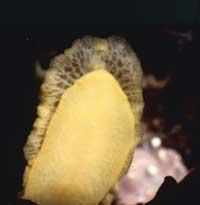
The evolutionary steps to the current evolved opistobranquios have been, to a large extent, those with the imprint of a weak internal shell. There are many examples of steps between masked and shelled opistobranchios, each of which has been the result of their adaptation to different environmental requirements.
This evolutionary tendency to shell loss began when the lateral lobe of the mantle begins to surround it. In this way, the shell became interior, completely disappearing from a moment (as it was internalizing, calcification was also simpler, since finally the shell was not formed). In this process, these initially folded lobes tended to cover the branchy (respiratory structure) (protection of the sand), but from the moment that these lobes cannot develop they will not be able to take oxygen.
In this way, the original branchy disappears and the secondary gills are configured until the development of the impressive and colorful prolongations that we have mentioned in the songs of the bees (these long tentacles remind the ears of the liebras). Sea
hares were known in the Roman Empire for the presence of morex substances that release when someone or something makes them feel uncomfortable, since, being powerful or toxic, they were used in poisonous preparation among other substances. The Greeks also believed that he had quite strange powers.
Therefore, the basis of the success of these small and unhappy marine rodents can be summarized in several points: On the one hand, because they have preferred the protection mechanisms they have developed, leaving the mechanical and passive protection used by their pioneers (the shell itself), biological and chemical protection (that is, the active one). Moreover, it has had to do, above all, with the strict distribution of the nudibranchs. They inhabit very specific ecological zones, where in most cases they do not have much pressure on other marine animals. It limits its distribution to the areas of the food species, so that each opistobranquial species is dispersed in a certain ecological corner and drastically reduces food competition.
Buletina
Bidali zure helbide elektronikoa eta jaso asteroko buletina zure sarrera-ontzian











